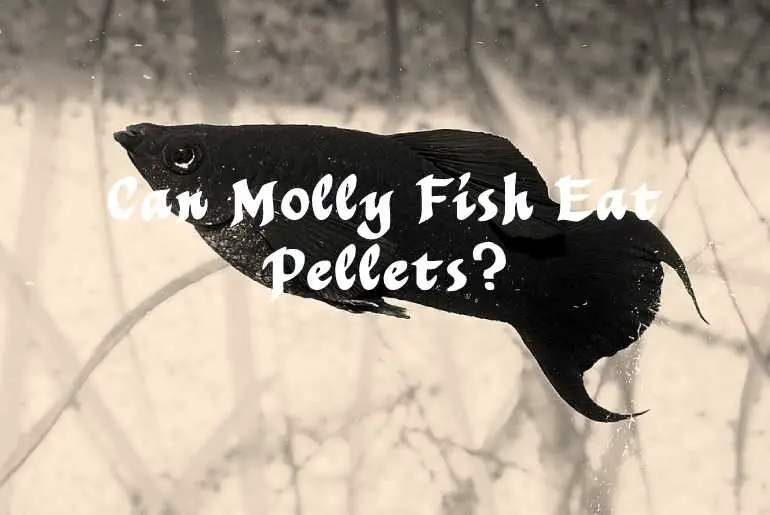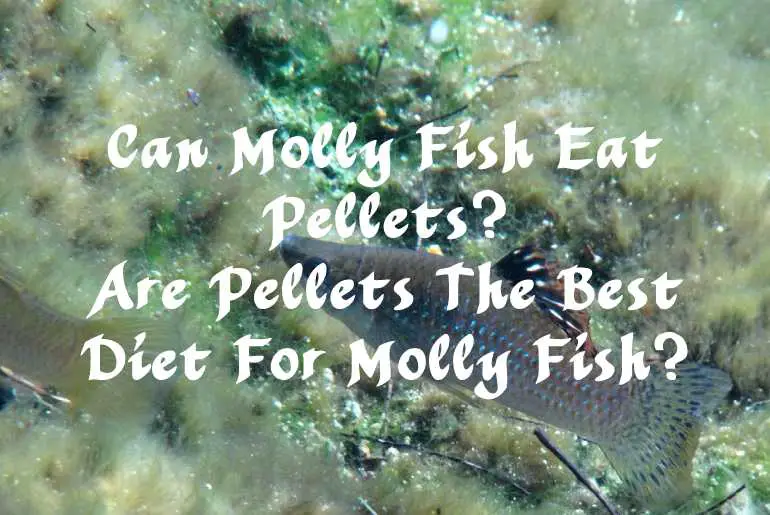Molly fish are tropical freshwater fish that can grow up to 3 inches long and have a lifespan that is around three to five years. These mollies are omnivores, which means they will eat various things like brine shrimps, bloodworms, etc. But Can Molly fish eat pellets? Since most owners aren’t much familiar with this dish, they have many questions regarding Molly’s food habits.
Yes, molly fish can eat pellets in the aquarium if you provide them the correct amount along with some alternate diet. The protein in the pellet is perfect for mollies who might need some extra help during their growth stages.
Besides this, this fish can also enjoy other types of food, such as brine shrimp and bloodworms, as they are not picky eaters.
In this post, I will give a detailed review of Molly fish, its food habits, and the pros and cons of pellets in their diet.
What Is Pellets Food?
After processing and grounding up the pellets by extruders, the pellets go through a toaster oven where you need to bake them for about two minutes.
They are cereals that contain grains and other ingredients, such as meat meals. Excess water moisture in pellet food will cause them to mold, so it is best not to feed your fish too many of these foods at one time.
Pellets are a good way to provide your fish with their nutrition. In addition, they come in various shapes and sizes, making it easier for you to find one that will suit every size tank.
In addition, you can change pellets into flakes or sticks, and some have different flavors, such as shrimp flavor or salmon oil, making them tastier than any other type of feed like live food or frozen food.
However, not all fish can eat pellets, so please note before feeding this type of diet to your pet. Some examples include butterflyfish (the barbels on their face make it difficult), loaches (they don’t require much protein), and discus fish (too high in fat).
Can Molly Fish Eat Pellets?
Molly fish can eat pellets as they are omnivores. They have a diet that consists of both plant and animal sources. Molly fishes mainly feed on insects, small crustaceans, or zooplankton.
This could include pieces of food such as krill, shrimp, and other smaller invertebrates. Molly fish are not picky when it comes to food, and they will eat anything that can fit into their mouth.
These fish have a wide-open mouth with teeth on the outside edges of their jaws, which is great for catching prey and makes them prone to bite off more than they can chew – this could mean swallowing something too big or even choking.

Molly Fish eat pellets, but live food like worms, crickets, flies, etc., is also important. These foods keep their growth rate normal and keep molly fish happy for the long run.
Also, mollies can eat mosquito larvae along with other live food like bloodworms, microworms, etc., and veggies like cucumber, zucchini, spinach, etc.
They need an active diet, so frozen bloodworms work well because they won’t spoil quickly in water temperatures. It would help if you used pellets sparingly to keep your Molly Fish happy and healthy.
What Are The Advantages Of Pellets In Molly Fish Diet?
Pellets are the main form of food for fish nowadays. There are many advantages to pellet feeding:
- Fish don’t have to work as hard for their food, and they can focus on other things like breeding or resting in peace.
- Pellets are also easier to feed in large quantities.
- Another advantage of pellets for fish is that they provide a balanced diet, allowing the fish to live longer and be healthier.
- Pellet feeding doesn’t disturb the water, which helps prevent the disease from spreading too quickly among predators and prey. In addition, because there’s not much wastage with pellets, unlike when you’re using flakes (which turn into muck), this reduces pollution levels in our waterways.”
- Pellets sink, so it’s easy for bigger fish with slower swim speeds to find them compared to flakes that float everywhere.
- Pellets help to compensate for the energy loss due to the bacteria or fungus present in your fish’s digestive tract.
What Are The Disadvantages Of Pellets In Molly Fish Diet?
Despite being an incredible nutritional source, pellets in the diet do have some drawbacks to the health of Molly fish. So, the disadvantages of feeding pellets to Molly fish are:
The pellets in the tank often decompose, meaning that Molly fish are overfed and search for more food.
- Pellets usually do not contain a lot of fatty acids or vitamin A. This can make them sick without other sources of nutrition.
- Feeding pellets extensively will lead to an unbalanced diet. For example, pellets do not contain enough vitamins B12 and D. It also doesn’t include essential amino acids like methionine, lysine, and taurine, which are critical for Molly’s life cycle (eggs larvae).
- Molly fish only need a few pellets per day. Therefore, pellets will stay in the stomach longer. This is because they are hard to digest and excrete. Thus, the more pellet eaten, the higher chance of constipation.
- Overfeeding Molly fish with pellets often causes the tank to get dirty and the water toxic. Molly fish also become susceptible to diseases because they are always hungry for more food. This is because they have a weak immune system.
- Pellets contain too much protein, leading to kidney problems, especially for molly fish. They also have a high percentage of calcium harmful to the aquarium environment and their bodies’ health condition.
Are Pellets The Best Diet For Molly Fish?
Molly fish are omnivores and can eat pellets for their diet. Molly fish enjoy eating various foods, from algae to ground meat and frozen peas or clams. They will also eat pellet-based diets in captivity, including Spirulina-based pellet diets or vegetable-based pellets like seaweed flavors.
Some owners also claim that pellets have some nutrients that Mollies need while controlling their weight. Pellets are also good for managing the aggression of Molly toward other animals within your home environment.
However, it is not a good idea to make pellets as a sole diet for Molly Fish. There needs to be a higher protein diet to ensure that your Molly fish will produce eggs and sperm.
Good Diet For Molly Fish
Molly fish is a beautiful species of freshwater tropical and subtropical fish that belongs to the Poecilia family. They are available in many shapes, sizes, and colors like black Molly, red Molly, blue Molly, etc.
Though they need a good diet for their growth, these mollies do not require any special care or maintenance compared with other aquarium fishes. But here we will give you some tips on what a good diet for Molly requires, which includes the following points:
- Feed them floating foods such as brine shrimp eggs and tubifex worms; this can provide excellent nutrition because it contains high levels of protein that helps build muscle tissue, among others.
- Maintain a stable pH level in water by adding calcium carbonate (or crushed coral). Molly fish are sensitive to water pH levels, so make sure that you monitor them.
- Stock your Molly fish tank with plenty of food and clean filter media. This will prevent algae or other contaminants from growing in the tank. Remember to change the water of the molly fish tank every week.
- Molly fish also need a high protein diet for their good health. You can feed them with blood worms, tubifex worms, and brine shrimp eggs.
- Feed them at least two times in one day but give food of small size which they can eat easily without any difficulty since Molly fishes are not very active as other aquarium fishes like goldfish, etc.
FAQs
How Long Can Molly Fish Live Without Food?
The timespan for molly fish to survive without food entirely depends on the size and age of mollies. While adult Mollies can live for a couple of weeks, molly fry will die without food within the next three days. So, research how often to feed your molly fish and what happens if you skip feeding these small beings.
What Does Molly Fish Eat?
Molly fish have an omnivore diet and eat meaty food like bloodworms, daphnia, and veggies like cucumber and zucchini.
These fish will eat anything you drop in the tank ranging from frozen live foods, vegetables, commercial foods like pellets, flakes, etc., and even algae present in the tank.
Conclusion
Summing up, Pellets are the most common Molly fish food of perfect bite-size. But feeding pellets as a sole Molly fish diet is not the best idea. Molly fish have a short gut and don’t process food very efficiently, so it’s important to provide Molly fish with some fiber in their diet as well.
Hopefully, this post cleared all your doubts about Molly’s fish and their diet. For more Molly fish-related articles, check this Molly fish blog.


